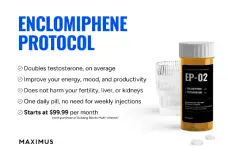madman
Super Moderator
* All included men had demonstrated fertility prior to vasectomy. The two reboot protocols included: hCG 3000 IU three times weekly, plus either enclomiphene/clomiphene 25 mg daily or FSH 75 IU three times weekly. A negative control group of men who had undergone TESA while on concurrent testosterone therapy without a reboot protocol was also identified
* Reinduction of spermatogenesis, or reboot, with either hCG+SERM or hCG+FSH appears to be successful, among men with proven prior fertility.
COMPARING REBOOT PROTOCOL FOR RETURN OF SPERMATOGENESIS IN MEN ON TESTOSTERONE THERAPY WITH PRIOR VASECTOMY DESIRING FUTURE FERTILITY
Taylor P. Kohn*, Blair T. Stocks, Mahdi A. Bazzi, Niki N. Parikh, Houston,TX; Corey A. Able, Galveston, TX; Amelia G. Oppenheimer,Larry I. Lipshultz, Houston, TX
INTRODUCTION AND OBJECTIVE
Men with prior vasectomy and on concurrent testosterone therapy (TTh) are difficult to manage as semen analysis cannot be used to determine if sperm has returned to the ejaculate; they often require testicular biopsy (TESA) prior to proceeding with vasectomy reversal or sperm extraction for IVF. For men on TTh, human chorionic gonadotropin (hCG) plus a selective estrogen receptor modulator (SERM) have been used to reinduce spermatogenesis; more recent regimens have combined hCG+FSH for a “reboot.” Men who previously fathered a child and then underwent vasectomy provide unique insight for reboot protocols after TTh, due to demonstration of prior fertility. The objective of this study is to compare efficacy of these two protocols (hCG+SERM vs hCG+FSH).
METHODS
Retrospective review of a single academic institution was performed to identify patients who 1) had a prior history of vasectomy, 2) were on TTh, 3) desired return of fertility and underwent a reboot protocol, and 4) had undergone TESA to assess for presence of sperm. All included men had demonstrated fertility prior to vasectomy. The two reboot protocols included: hCG 3000 IU three times weekly, plus either enclomiphene/clomiphene 25 mg daily or FSH 75 IU three times weekly. A negative control group of men who had undergone TESA while on concurrent testosterone therapy without a reboot protocol was also identified. Primary outcome was presence of sperm at the time of TESA. We also detailed whether men opted for vasectomy reversal or sperm retrieval with IVF/ICSI.
RESULTS
A total of 20 men were identified: 8 received hCG+SERM and 12 received hCG+FSH. Men had similar ages (49 vs 43 years, p=0.70) and duration since vasectomy (12 vs 13 years, p=0.93), respectively. All men had sperm identified on TESA. Median interval between the beginning of reboot therapy and TESA was 3 months in both groups (p=0.07, range 3-9 months). Two men in this cohort had a history of TESA or TESE while on testosterone (prior to reboot) at an outside institution with no sperm identified. Of 20 men, 10 men had successful TESE for IVF/ICSI, 5 underwent vasectomy reversals (all with return of sperm in the ejaculate), 2 have vasectomy reversals planned, 1 has a TESE planned, and 2 were no longer interested in fertility after TESA and restarted TTh.
CONCLUSIONS
Reinduction of spermatogenesis, or reboot, with either hCG+SERM or hCG+FSH appears to be successful, among men with proven prior fertility. This is the first series examining outcomes in men on TTh and with vasectomy. TESA at or after 3 months following initiation of reboot therapy is an effective measure to detect sperm prior to TESE or vasectomy reversal.
* Reinduction of spermatogenesis, or reboot, with either hCG+SERM or hCG+FSH appears to be successful, among men with proven prior fertility.
COMPARING REBOOT PROTOCOL FOR RETURN OF SPERMATOGENESIS IN MEN ON TESTOSTERONE THERAPY WITH PRIOR VASECTOMY DESIRING FUTURE FERTILITY
Taylor P. Kohn*, Blair T. Stocks, Mahdi A. Bazzi, Niki N. Parikh, Houston,TX; Corey A. Able, Galveston, TX; Amelia G. Oppenheimer,Larry I. Lipshultz, Houston, TX
INTRODUCTION AND OBJECTIVE
Men with prior vasectomy and on concurrent testosterone therapy (TTh) are difficult to manage as semen analysis cannot be used to determine if sperm has returned to the ejaculate; they often require testicular biopsy (TESA) prior to proceeding with vasectomy reversal or sperm extraction for IVF. For men on TTh, human chorionic gonadotropin (hCG) plus a selective estrogen receptor modulator (SERM) have been used to reinduce spermatogenesis; more recent regimens have combined hCG+FSH for a “reboot.” Men who previously fathered a child and then underwent vasectomy provide unique insight for reboot protocols after TTh, due to demonstration of prior fertility. The objective of this study is to compare efficacy of these two protocols (hCG+SERM vs hCG+FSH).
METHODS
Retrospective review of a single academic institution was performed to identify patients who 1) had a prior history of vasectomy, 2) were on TTh, 3) desired return of fertility and underwent a reboot protocol, and 4) had undergone TESA to assess for presence of sperm. All included men had demonstrated fertility prior to vasectomy. The two reboot protocols included: hCG 3000 IU three times weekly, plus either enclomiphene/clomiphene 25 mg daily or FSH 75 IU three times weekly. A negative control group of men who had undergone TESA while on concurrent testosterone therapy without a reboot protocol was also identified. Primary outcome was presence of sperm at the time of TESA. We also detailed whether men opted for vasectomy reversal or sperm retrieval with IVF/ICSI.
RESULTS
A total of 20 men were identified: 8 received hCG+SERM and 12 received hCG+FSH. Men had similar ages (49 vs 43 years, p=0.70) and duration since vasectomy (12 vs 13 years, p=0.93), respectively. All men had sperm identified on TESA. Median interval between the beginning of reboot therapy and TESA was 3 months in both groups (p=0.07, range 3-9 months). Two men in this cohort had a history of TESA or TESE while on testosterone (prior to reboot) at an outside institution with no sperm identified. Of 20 men, 10 men had successful TESE for IVF/ICSI, 5 underwent vasectomy reversals (all with return of sperm in the ejaculate), 2 have vasectomy reversals planned, 1 has a TESE planned, and 2 were no longer interested in fertility after TESA and restarted TTh.
CONCLUSIONS
Reinduction of spermatogenesis, or reboot, with either hCG+SERM or hCG+FSH appears to be successful, among men with proven prior fertility. This is the first series examining outcomes in men on TTh and with vasectomy. TESA at or after 3 months following initiation of reboot therapy is an effective measure to detect sperm prior to TESE or vasectomy reversal.














